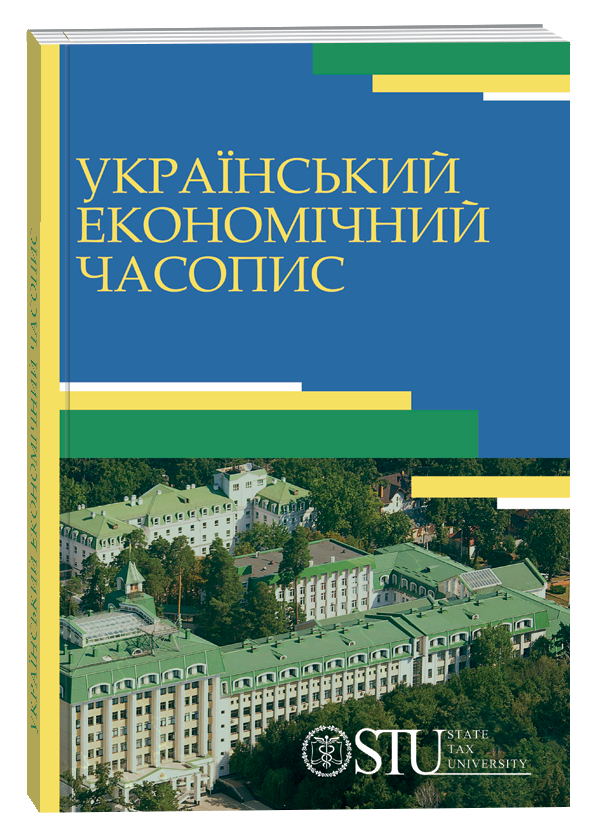SOCIAL MOBILITY OF EMPLOYEES: IMPACT ON SOCIAL SECURITY AND SUSTAINABLE DEVELOPMENT
DOI:
https://doi.org/10.32782/2786-8273/2025-9-18Keywords:
social mobility, social security, sustainable development, financial well-being, education, contract, injuriesAbstract
Introduction. A person's working life is inevitably associated with movement, but the impact of this phenomenon on social security and sustainable development has not been studied. Purpose. The purpose of the article is to analyze and evaluate the impact of social mobility of the working population on the social security of the individual and the country, as well as the possibility of strengthening Ukraine's sustainable development through these processes. Methods. The study uses an interdisciplinary and ecosystem approach; the methodological basis is also based on the methods of system analysis, synthesis, generalization and comparison. Results. The article summarizes and identifies the key factors of social mobility. It is proposed to understand social security as a prerequisite for achieving sustainable development. The correlation between education, social mobility and the level of social security is proved. It is determined that in case of non-cooperation between the social partners, the level of social security decreases and the possibilities of achieving sustainable development are reduced. It is found that social security is not achieved only through the positive dynamics of social mobility. It is established that seasonal work has a negative impact on social security. The factor of worker injuries is studied through the prism of social mobility and it is found that it impedes the country's achievement of the Sustainable Development Goals (Goal 8). The relationship between social mobility and social security through the manifestation of social risks and dangers is assessed. Conclusion. An important result is the establishment of a link (influence) between the social mobility of employees and the dynamics of the level of social security (the value of 0.86 is a close connection). At the same time, the main attention should be paid to the determinants of this phenomenon - education, staff development, safe working conditions, remuneration, etc. Given the above, it is necessary to continue research in this area to find alternative ways to achieve the country's sustainable development goals.
References
Бичук І. О., Червона С. П., Волченко Н. В. Соціальна мобільність у сучасному суспільстві : дослідження факторів, що впливають на підвищення чи зниження соціального статусу. Habitus. 2024. № 60. URL: https://repo.snau.edu.ua:8080/xmlui/handle/123456789/12169 (дата звернення: 20.03.2025)
Біль М. М. Мобільність населення: теоретична сутність і видова різноманітність. Економіка і суспільство. 2016. № 7. С. 645-652.
Боброва Д., Дон О. Міжнародна трудова міграція та її вплив на ринок праці України в умовах військової агресії РФ. Галицький економічний вісник. 2023. Том 82. № 3. С. 216-226.
Гетьманцева Н. Д. Трудова мобільність як чинник соціально-економічного розвитку країни. Юридичний науковий електронний журнал. 2024. № 5. DOI: https://doi.org/10.32782/2524-0374/2024-5/55
Поплавська О. М., Шевчук О. В. Феномен бідності працюючого населення: причини, наслідки, шляхи подолання. Галицький економічний вісник. 2020. № 4. С. 50-59. DOI: https://doi.org/10.33108/galicianvisnyk_tntu2020.04.050
Праця України. Статистичний збірник. Державна служба статистики. URL: https://ukrstat.gov.ua/druk/publicat/kat_u/publ11_u.htm (дата звернення: 02.04.2025)
Професійний стандарт «Бібліотекар». Наказ Державного агентства України з питань мистецтв та мистецької освіти від 10.03.2025р. № 17. URL: https://register.nqa.gov.ua/profstandart/bibliotekar (дата звернення: 27.03.2025)
Робоча сила України. Статистичний збірник. Державна служба статистики. URL: https://ukrstat.gov.ua/druk/publicat/kat_u/publ11_u.htm (дата звернення: 02.04.2025)
Сенюра О. Соціальна мобільність як індикатор суспільних змін: сучасний науковий дискурс. Грані. 2024. Том 27 № 6. DOI: https://doi.org/10.15421/1724111
Травматизм на виробництві. Статистичний збірник. Державна служба статистики. URL: https://ukrstat.gov.ua/operativ/operativ2020/m_w/travm_vyrob.html (дата звернення: 28.03.2025)
Шпекторенко І. Соціальна мобільність як наукова проблема соціального управління: соціальні інститути, соціальні ліфти. Аспекти публічного управління. 2024. Том 12. № 1. DOI: https://doi.org/10.15421/152409
2024: UN Humanitarian Forecasts for Ukraine. United Nations. 2025. URL: https://unric.org/en/2024-un-humanitarian-forecasts-for-ukraine/ (дата звернення: 30.03.2025)
Corman, S., Croitoru, A. Exploring Hidden Costs of Seasonal Migration in Agriculture within Roma Communities of Origin: Evidence from Romania. Societies. 2023. №13(11), р. 239. DOI: https://doi.org/10.3390/soc13110239
Day Martin V., Fiske Susan T. Understanding the Nature and Consequences of Social Mobility Beliefs. The Social Psychology of Inequality: monograph. Springer International Publishing. 2019. p. 365-380. DOI: https://doi.org/10.1007/978-3-030-28856-3_23
Eyles Andrew, Elliot Major Lee, Machin Stephen. Social mobility – past, present and future. Sutton Trust. 2022. URL: https://www.suttontrust.com/wp-content/uploads/2022/06/Social-Mobility-%E2%80%93-Past-Present-and-Future.pdf (дата звернення: 25.03.2025)
Kharazishvil, Yu., Kwilinski A., Grishnova O., Dzwigol H. Social Safety of Society for Developing Countries to Meet Sustainable Development Standards: Indicators, Level, Strategic Benchmarks (with Calculations Based on the Case Study of Ukraine). Sustainability. 2020. Vol. 12, №2 1. DOI: https://doi.org/10.3390/su12218953
Bychuk I. O., Chervona S. P., Volchenko N. V. (2024). Sotsialna mobilnist u suchasnomu suspilstvi : doslidzhennia faktoriv, shcho vplyvaiut na pidvyshchennia chy znyzhennia sotsialnoho statusu [Social mobility in modern society: a study of the factors influencing the increase or decrease of social status]. Habitus – Habitus, vol. 60. URL: https://repo.snau.edu.ua:8080/xmlui/handle/123456789/12169 (accessed March 20, 2025)
Bil M. M. (2016). Mobilnist naselennia: teoretychna sutnist i vydova riznomanitnist [Population mobility: theoretical essence and species diversity]. Ekonomika i suspilstvo – Economy and society, vol. 7, р. 645–652.
Bobrova D., Don O. (2023). Mizhnarodna trudova mihratsiia ta yii vplyv na rynok pratsi Ukrainy v umovakh viiskovoi ahresii RF. [nternational labor migration and its impact on the labor market of Ukraine in the context of military aggression of the Russian Federation]. Halytskyi ekonomichnyi visnyk – Galician Economic Herald, vol. 82, no. 3, р. 216–226.
Hetmantseva N. D. (2024). Trudova mobilnist yak chynnyk sotsialno-ekonomichnoho rozvytku krainy [Labor mobility as a factor of socio-economic development of the country]. Yurydychnyi naukovyi elektronnyi zhurnal – Legal scientific electronic journal, vol. 5. DOI: https://doi.org/10.32782/2524-0374/2024-5/55
Poplavska O. M., Shevchuk O. V. (2020). Fenomen bidnosti pratsiuiuchoho naselennia: prychyny, naslidky, shliakhy podolannia [The phenomenon of working population poverty: causes, consequences, ways to overcome]. Halytskyi ekonomichnyi visnyk – Galician Economic Herald, vol. 4, р. 50–59. DOI: https://doi.org/10.33108/galicianvisnyk_tntu2020.04.050
Pratsia Ukrainy. Statystychnyi zbirnyk. Derzhavna sluzhba statystyky [Labor of Ukraine. Statistical collection. State Statistics Service of Ukraine]. URL: https://ukrstat.gov.ua/druk/publicat/kat_u/publ11_u.htm (accessed April 02, 2025)
Profesiinyi standart «Bibliotekar». Nakaz Derzhavnoho ahentstva Ukrainy z pytan mystetstv ta mystetskoi osvity vid 10.03.2025 r. vol. 17 [Professional standard “Librarian”. Order of the State Agency of Ukraine for Arts and Art Education dated 10.03.2025, vol. 17]. Available at: https://register.nqa.gov.ua/profstandart/bibliotekar (accessed March 27, 2025)
Robocha syla Ukrainy. Statystychnyi zbirnyk. Derzhavna sluzhba statystyky [Labor force of Ukraine. Statistical collection. State Statistics Service of Ukraine]. Available at: https://ukrstat.gov.ua/druk/publicat/kat_u/publ11_u.htm (accessed April 02, 2025)
Seniura O. (2024). Sotsialna mobilnist yak indykator suspilnykh zmin: suchasnyi naukovyi dyskurs [Social mobility as an indicator of social change: modern scientific discourse]. Hrani – Grani, vol. 27, no. 6. DOI: https://doi.org/10.15421/1724111
Travmatyzm na vyrobnytstvi. Statystychnyi zbirnyk. Derzhavna sluzhba statystyky [Injuries at work. Statistical collection. State Statistics Service of Ukraine]. Available at: https://ukrstat.gov.ua/operativ/operativ2020/m_w/travm_vyrob.html (accessed March 28, 2025)
Shpektorenko I. (2024). Sotsialna mobilnist yak naukova problema sotsialnoho upravlinnia: sotsialni instytuty, sotsialni lifty [Social mobility as a scientific problem of social management: social institutions, social elevators]. Aspekty publichnoho upravlinnia – Aspects of public administration, vol. 12, no 1. DOI: https://doi.org/10.15421/152409
2024: UN Humanitarian Forecasts for Ukraine. (2025). United Nations. Available at: https://unric.org/en/2024-un-humanitarian-forecasts-for-ukraine/ (accessed March 30, 2025)
Corman, S., Croitoru, A. (2023). Exploring Hidden Costs of Seasonal Migration in Agriculture within Roma Communities of Origin: Evidence from Romania. Societies, vol. 13(11), р. 239. DOI: https://doi.org/10.3390/soc13110239
Day Martin V., Fiske Susan T. (2019). Understanding the Nature and Consequences of Social Mobility Beliefs. The Social Psychology of Inequality: monograph. Springer International Publishing, p. 365-380. DOI: https://doi.org/10.1007/978-3-030-28856-3_23
Eyles Andrew, Elliot Major Lee, Machin Stephen. (2022). Social mobility – past, present and future. Sutton Trust. Available at: https://www.suttontrust.com/wp-content/uploads/2022/06/Social-Mobility-%E2%80%93-Past-Present-and-Future.pdf (accessed March 25. 2025)
Kharazishvil, Yu., Kwilinski A., Grishnova O., Dzwigol H. (2020). Social Safety of Society for Developing Countries to Meet Sustainable Development Standards: Indicators, Level, Strategic Benchmarks (with Calculations Based on the Case Study of Ukraine). Sustainabilit, vol. 12, no. 21. DOI: https://doi.org/10.3390/su12218953



